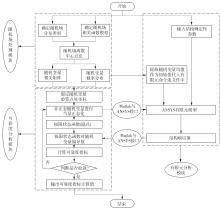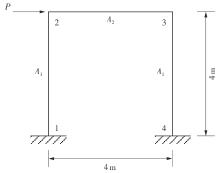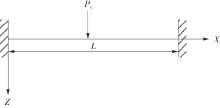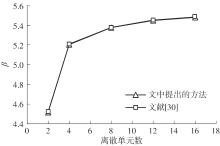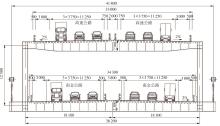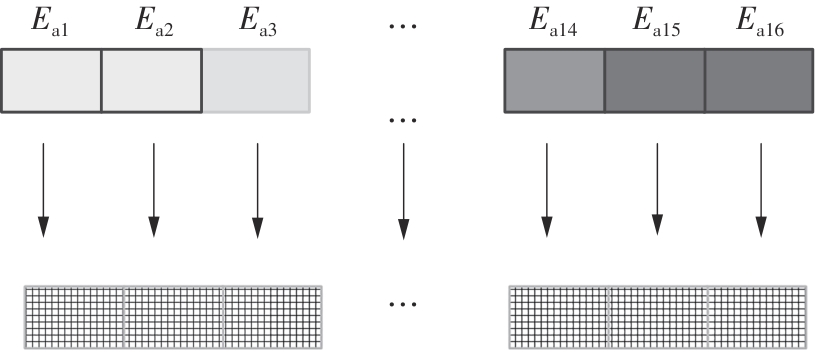Journal of South China University of Technology(Natural Science Edition) ›› 2025, Vol. 53 ›› Issue (4): 13-21.doi: 10.12141/j.issn.1000-565X.240076
• Architecture & Civil Engineering • Previous Articles Next Articles
Deflection Reliability Assessment Method of Long-Span Suspension Bridge Based on Random Field
CHENG Jin1,2, SUN Kedi1, YUAN Yi1
- 1.College of Civil Engineering,Tongji University,Shanghai 200092,China
2.State Key Laboratory of Disaster Reduction in Civil Engineering,Tongji University,Shanghai 200092,China
-
Received:2024-02-08Online:2025-04-25Published:2024-11-08 -
Contact:孙克荻(2000 —),男,硕士生,主要从事大跨桥梁研究。 E-mail:13521523833@163.com -
About author:程进(1971—),男,博士,研究员,主要从事大跨桥梁研究。E-mail: chengjin@tongji.edu.cn -
Supported by:the National Key R & D Program of China(2021YFB1600300)
CLC Number:
Cite this article
CHENG Jin, SUN Kedi, YUAN Yi. Deflection Reliability Assessment Method of Long-Span Suspension Bridge Based on Random Field[J]. Journal of South China University of Technology(Natural Science Edition), 2025, 53(4): 13-21.
share this article
| 1 | 楼庄鸿 .国外大跨径悬索桥述评[J].中国公路学报,1991,4(4):67-76. |
| LOU Zhuanghong .A review of large-span suspension bridges abroad[J].China Journal of Highway and Transport,1991,4(4):67-76. | |
| 2 | 朱红霞 .随机场理论在地基可靠度分析中的应用研究[D].天津:天津大学,2007. |
| 3 | VANMARCKE E H .Probabilistic modeling of soil profiles[J].ASCE Journal of the Geotechnical Engineering Division,1977,103(11):1227-1246. |
| 4 | LI K S, LUMB P .Probabilistic design of slopes[J].Canadian Geotechnical Journal,1987,24(4):520-535. |
| 5 | 包乘纲,高大钊,张庆华 .地基工程可靠度分析方法研究[M].武汉:武汉测绘科技大学出版社,1996. |
| 6 | 高大钊 .土力学可靠性原理[M].北京:中国建筑工业出版社,1989. |
| 7 | 彭大鹏 .齐次随机场在分析土性指标中的应用[J].天津大学学报,1992,38(2):118-124. |
| PENG Dapeng .Application of homogeneous random field to analyze indexes of soil properties[J].Journal of Tianjin University,1992,38(2):118-124. | |
| 8 | 刘春华,秦权 .材料变异时大跨悬索桥的静力分析[J].清华大学学报(自然科学版),1997,37(6):91-94. |
| LIU Chunhua, QIN Quan .Static analysis for long span suspension bridges with random property[J].Journal of Tsinghua University (Science and Technology),1997,37(6):91-94. | |
| 9 | 葛耀君,项海帆 .桥梁颤振的随机有限元分析[J].土木工程学报,1999,32(4):27-32. |
| GE Yaojun, XIANG Haifan .Stochastic finite element analysis of bridge flutter[J].China Civil Engineering Journal,1999,32(4):27-32. | |
| 10 | 黄斌,李烨君,朱礼平,等 .桥塔抗弯刚度随机性对斜拉桥动力特性的影响[J].西南交通大学学报,2014,49(2):202-207. |
| HUANG Bin, LI Yejun, ZHU Liping,et al .Effects of towers’random sectional bending stiffness on dynamic characteristics of large-span cable-stayed bridge[J].Journal of Southwest Jiaotong University,2014,49(2):202-207. | |
| 11 | 黄林杰 .基于随机有限元法的非机动车钢桥摩擦型高强螺栓可靠性分析[J].科学技术与工程,2022,22(21): 9321-9330. |
| HUANG Lin-jie .Reliability of friction high strength bolts for non-motor vehicle steel bridges based on stochastic finite element analysis[J].Science Technology and Engineering,2022,22(21):9321-9330. | |
| 12 | 林道锦,秦权 .一座现有拱桥面内失稳的可靠度随机有限元分析[J].工程力学,2005(6):122-126. |
| LIN Daojin, QIN Quan .Reliability stochastic finite element analysis of in-plane buckling for an existing arch bridge[J].Engineering Mechanics,2005(6):122-126. | |
| 13 | 李小珍,辛莉峰,肖林,等 .考虑轨道不平顺全概率分布的车桥随机分析方法[J].土木工程学报,2019,52(11):71-78. |
| LI Xiaozhen, XIN Lifeng, XIAO Lin,et al .A stochastic analysis method of train-bridge interactions considering full probability distribution of track irregularities [J].China Civil Engineering Journal,2019,52(11):71-78. | |
| 14 | 贾思毅 .基于预应力混凝土桥挠度的结构状态概率反演及性能评估[D].北京:北京交通大学,2022. |
| 15 | 陈哲衡 .大跨径PSC箱梁桥时变性能监测及状态评估[D].南京:东南大学,2018. |
| 16 | 张慧,王文科,陈楚龙,等 .考虑施工误差的大跨度混合梁斜拉桥全过程施工可靠性分析[J].青海交通科技,2019(6):101-108. |
| ZHANG Hui, WANG Wenke, CHEN Chulong,et al .Reliability analysis of long span hybrid girder cable- stayed bridge during whole process considering construction error[J].Qinghai Transportation Science and Techno-logy,2019(6):101-108. | |
| 17 | KUSANO I, BALDOMIR A, JURADO J A,et al .Reliability based design optimization of long-span bridges considering flutter[J].Journal of Wind Engineering and Industrial Aerodynamics,2014,135(2):149-162. |
| 18 | 方根深,赵林,卫苗苗,等 .沿海典型大跨桥梁桥址区台风极端风荷载预测与应用[J].同济大学学报(自然科学版),2021,49(10):1390-1398. |
| FANG Genshen, ZHAO Lin, WEI Miaomiao,et al .Estimation and application of typhoon extreme wind loadings at typical long-span bridge sites in coastal regions [J].Journal of Tongji University (Natural Science),2021,49(10):1390-1398. | |
| 19 | 郭俊峰 .大跨度钢箱梁悬索桥涡振与颤振可靠度研究[D].成都:西南交通大学,2018. |
| 20 | 陈水生,赵辉,李锦华,等 .实际车流荷载作用的混凝土梁桥可靠度评估[J].振动与冲击,2022, 41(20):158-167. |
| CHEN Shuisheng, ZHAO Hui, LI Jinhua,et al .Reliability assessment of a concrete beam bridge under actual traffic load[J].Journal of Vibration and Shock, 2022,41(20):158-167. | |
| 21 | 刘浪,杨洪 .重载并行对中小跨径梁桥可靠度的影响[J].重庆交通大学学报(自然科学版),2023, 42(2):13-18. |
| LIU Lang, YANG Hong .Influence of multiple pre-sences of heavy traffic on the reliability of medium and small span bridges[J].Journal of Chongqing Jiaotong University (Natural Science),2023,42(2):13-18. | |
| 22 | 朱金,吴梦雪,尹力,等 .随机车流-风联合作用下沿海大跨度斜拉桥拉索疲劳寿命预测[J].中国公路学报,2020,33(11):182-194. |
| ZHU Jin, WU Meng-xue, YIN Li,et al .Fatigue life prediction of cable used in costal long-span cable-stayed bridges under stochastic traffic and wind loads[J].China Journal of Highway and Transport,2020,33(11):182-194. | |
| 23 | 王涛,刘德贵,张兴标 .风、列车作用下斜拉桥索-梁相关振动对拉索疲劳可靠性的影响[J].振动与冲击,2021,40(7):154-163,230. |
| WANG Tao, LIU Degui, ZHANG Xingbiao .Effects of cable-beam related vibration on cable fatigue reliability of cable stayed bridge under wind and train action[J].Journal of Vibration and Shock,2021,40(7):154-163,230. | |
| 24 | 周小燚,王能威,汪昕,等 .随机-区间混合不确定性下FRP桁架桥多尺度可靠性分析[J].中国公路学报,2022,35(2):63-75. |
| ZHOU Xiao-yi, WANG Neng-wei, WANG Xin,et al .Multi-scale reliability analysis of FRP truss bridge with hybrid random and interval uncertainty[J].China Journal of Highway and Transport,2022,35(2):63-75. | |
| 25 | 潘邦群,王希瑞 .基于改进一次二阶矩法的连续刚构桥体系可靠度评估分析[J].西部交通科技,2022(9):98-100. |
| PAN Bangqun, WANG Xirui .Reliability evaluation analysis of continuous rigid frame bridge system based on improved first-order second-moment method[J].Western China Communications Science and Technology,2022(9):98-100. | |
| 26 | HAN Y, LI K, CAI C S,et al .Fatigue reliability assessment of long-span steel-truss suspension bridges under the combined action of random traffic and wind loads[J].Journal of Bridge Engineering,2020,25(3):04020003/1-32. |
| 27 | 张清利,刘健,洪博文,等 .基于随机车流的白洋长江公路大桥钢桁梁杆件疲劳损伤分析[J].世界桥梁,2022,50(5):87-93. |
| ZHANG Qing-li, LIU Jian, HONG Bo-wen,et al .Fatigue damage analysis of steel truss members of Baiyang Changjiang river highway bridge under random vehicle volume[J].World Bridges,2022,50(5):87-93. | |
| 28 | 丁亮 .基于拟蒙特卡罗法的大跨悬索桥挠度可靠度分析[J].交通科技,2023,137(2):102-106. |
| DING Liang .Deflection reliability analysis of long-span suspension bridge based on Quasi-Monte Carlo method[J].Transportation Science and Technology,2023, 137(2):102-106. | |
| 29 | 赵国藩 .工程结构可靠性理论与应用[M].大连:大连理工大学出版社,1996. |
| 30 | HISADA T, NAKAGIRI S .Stochastic finite element method developed for structural safety and reliability [C]∥ Proceedings of the 3rd International Conference on Structural Safety and Reliability.Trondheim:International Association for Structural Safety and Reliability,1981:395-408. |
| 31 | 马碧波,叶雨清,白雨东,等 .瓯江北口大桥中塔设计及索鞍施工预偏量影响研究[J].桥梁建设,2018,48(6):41-46. |
| MA Bi-bo, YE Yu-qing, BAI Yu-dong,et al .Design and research on intermediate tower & pre-deflection of saddles in the construction of Oujiang River North Estuary Bridge[J].Bridge Construction,2018,48(6):41-46. |
| [1] | JIN Qichao, LI Jun, WANG Liangliang, TAN Haibing, LI Fulin, FU Rui, MENG Lingchao, GUO Lei. Mechanism of Saw Tooth-Shaped Chip Formation in Cast & Wrought High-Temperature Alloy GH4198 [J]. Journal of South China University of Technology(Natural Science Edition), 2025, 53(5): 32-44. |
| [2] | LI Min, YAO Qishui. Calculation of Fatigue Life of Rubber Vibration Isolators Under Random Vibration Loads [J]. Journal of South China University of Technology(Natural Science Edition), 2024, 52(12): 14-21. |
| [3] | CHEN Zhong, QIU Yuliang, ZHANG Xianmin. Optimization Design and Experiment of XY Compliant Platform with Local Resonance Damping [J]. Journal of South China University of Technology(Natural Science Edition), 2024, 52(12): 1-13. |
| [4] | LIU Yan, CHEN Yixian, WANG Xin, et al. Analysis of the Ultimate Bearing Capacity of the Π-Joint of Welded Square Tube Under Axial Load [J]. Journal of South China University of Technology(Natural Science Edition), 2024, 52(11): 32-42. |
| [5] | DING Faxing, CAI Yongqiang, WANG Liping, et al.. Seismic Performance Analysis of Welded Multi-Cavity Double Steel Plate-Concrete Composite Shear Wall [J]. Journal of South China University of Technology(Natural Science Edition), 2024, 52(1): 15-25. |
| [6] | CHEN Zhong XIE Shengyang ZHANG Xianmin. Design Of A Two DOF Hybrid Compliant Gripper Based On Electromagnetic Drive [J]. Journal of South China University of Technology(Natural Science Edition), 2021, 49(12): 35-42. |
| [7] | ZANG Mengyan, WANG Lichen, ZHOU Tao, et al. Finite Element Simulation Analysis and Evaluation of Radial Tire's Transient Dynamic Characteristics [J]. Journal of South China University of Technology (Natural Science Edition), 2020, 48(8): 124-129. |
| [8] | JIN Xia, HU Juncong, WANG Wei, et al. Adjustment Strategy for Automobile Hood Matching in Virtual Environment [J]. Journal of South China University of Technology (Natural Science Edition), 2020, 48(6): 87-96. |
| [9] | SHI Guangfeng HUO Mingjie WANG Zitao. Fluid-Solid Coupling Modal Analysis of Sessile Droplets [J]. Journal of South China University of Technology (Natural Science Edition), 2020, 48(2): 137-142,150. |
| [10] | SHI Xuefei, GAO Yi, CAO Shenghui. Experimental Study on Mechanical Behavior of UHPC Joint of Precast Bridge Deck [J]. Journal of South China University of Technology(Natural Science Edition), 2020, 48(12): 82-90,124. |
| [11] | TANG Liang LI Yi ZHANG Zhirui CHENG Yiming SHANGGUAN Wenbin. Modal Analysis and Optimization of Vehicle Steering System [J]. Journal of South China University of Technology(Natural Science Edition), 2019, 47(9): 83-89. |
| [12] | XIA Ye, WANG Peng, LEI Wei, et al. Neutral Axis Position-Based Monitoring Method and Indicator for Structural Evaluation of Concrete Girder Bridges [J]. Journal of South China University of Technology (Natural Science Edition), 2019, 47(12): 62-71. |
| [13] | SHI Kairong, XU Jiebin, JIANG Zhengrong, et al. Horizontal Compressive Capacity of the Joints for the New Type Nested Steel Tubular Scaffold [J]. Journal of South China University of Technology (Natural Science Edition), 2019, 47(12): 43-52. |
| [14] |
ZENG Fanliang HUANG Yansheng ZHOU Jing.
Reliability Verification for Seismic Capacity Utilization Factors of Structure
|
| [15] | LIU Gang LI Yang CHEN Yuan YANG Yu-hang. Effect of Radial Temperature Difference on Sag Calculation for Overhead Conductors [J]. Journal of South China University of Technology (Natural Science Edition), 2017, 45(7): 41-47,54. |
| Viewed | ||||||
|
Full text |
|
|||||
|
Abstract |
|
|||||
